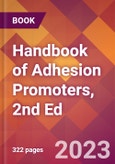Adhesion promoters form a significant group of additives, without, which many industrial products cannot perform according to requirements. The knowledge on this subject mostly related to silanes, which form the most widely used group of these additives, is frequently based on the book which was published at the beginning of 1980s by a scientist who developed many silanes used until today. Since then, many new additives were introduced into the market. Most of these new additives are not based on silanes but on one of over 30 chemical groups of chemical compounds needed for a variety of products in which silanes do not function, are too expensive, or better performance can be achieved with these new additives.
This book fills the existing gap in the literature, which still lacks the most recent comprehensive review of current options and knowledge. Handbook of Adhesion Promoters contains 10 chapters, each discussing essential aspects of the application of adhesion promoters. The known mechanisms which belong to one of 13 groups outline principles of use, action, and application of these additives. This chapter is followed by the discussion of mechanisms that cause adhesion loss, such as corrosion, delamination, detachment, liquid penetration, and peeling.
Surface condition and its treatment are discussed regarding surface treatment by different methods (cleaning, mechanical, plasma, microwave, flame, corona discharge, laser, UV, and chemical modification), which are used in practical applications. All these are illustrated with practical examples.
Chapter 5 gives formulations of typical primers used in the application of adhesives and sealants, coatings, coil coatings, cosmetics, dental, leather, metal, optical devices, paper, polymers and plastics, printing, and wood. This chapter contains over 50 primer formulations.
A full chapter is devoted to the subject of polymer modification which can improve adhesion - a method frequently used instead of the addition of adhesion promoters. The properties of (over 30 groups of adhesion promoters and their potential applications are discussed in the chapter devoted to this subject based on published articles, manufacturers’ information, and analysis of patents.
The last three chapters contain information on available evaluation and selection of adhesion promoters that work with different polymers (29), products (28) and help to prevent corrosion. A full list of covered polymers and products is given in the table of contents below.
In addition to the theoretical and practical knowledge required to effectively formulate products used in various applications discussed in this book, there is also available Databook of Adhesion Promoters, which contains data on many most extensively used commercial additives. Both books contain the most recent information available in literature, patents, and published by manufacturers and users of these products.
The Handbook of Adhesion Promoters is an important reference for chemists, engineers, and materials scientists in various industries. It is also suitable as a reference book for advanced graduate students.
It is recommended for readers interested in all aspects of polymers and plastics, with special attention to the development, studies, legislation, and production of adhesives, aerospace, agriculture, automotive, bitumen, ceramic tiles, coated fabrics, coatings and paints, coil coatings, composites, construction, cosmetics, dental, electrodes, electronics, flooring, food applications, inks, laminates, medical, membranes, metal coating, pharmaceutical, roofing, sealants, tires, waterproofing, and wire & cable.








